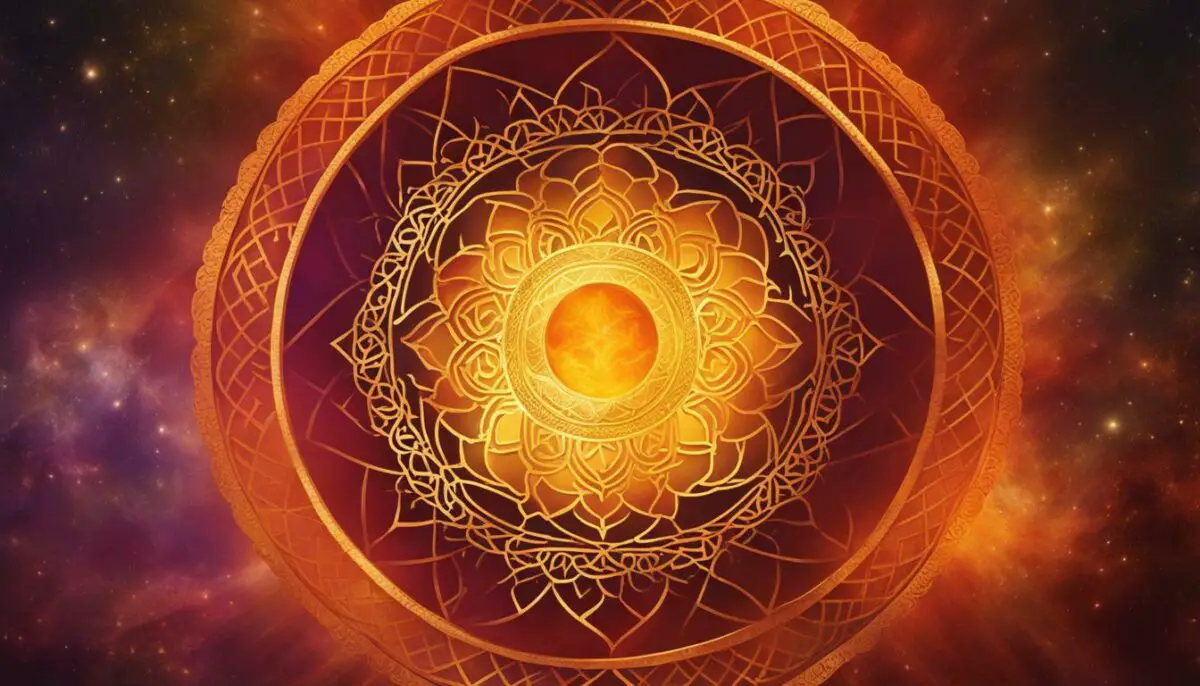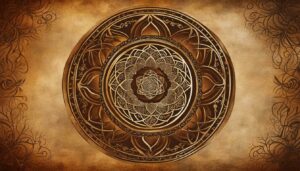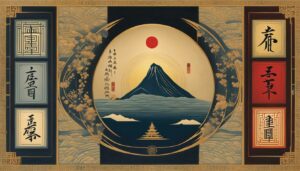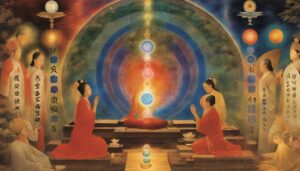Traverse back through the riveting history of Reiki, beginning in early 20th-century Japan, taking through the molding of Mikao Usui’s renowned Usui Reiki Ryoho. This comprehensive overview introduces the styles of Reiki in Japan, leading to Usui’s transformative mystical experience on Mount Kurama.
Key Takeaways:
- Reiki has a development history that dates back to the early 20th century in Japan.
- Prior to Mikao Usui’s style of Reiki, there were already four other styles of Reiki being practiced in Japan.
- Mikao Usui’s mystical experience on Mount Kurama led to the development of Usui Reiki Ryoho.
- Hawaya Takata played a significant role in bringing Reiki to the West and popularizing Usui’s style.
- Reiki has ancient origins and has been passed down through generations, despite the lack of written records about Dr. Usui’s original teachings.
- The Reiki energy transmitted by Western Reiki teachers has been validated, contributing to its worldwide popularity.
Various Styles of Reiki in Japan before Mikao Usui
Prior to Mikao Usui’s development of his style of Reiki, there were already at least four other styles being practiced in Japan. These styles included Reiki Ryoho created by Mataji Kawakami, Reikan Tonetsu Ryoho created by Reikaku Ishinuki, Senshinryu Reiki Ryoho created by Kogetsu Matsubara, and Seido Reishojutsu created by Reisen Oyama. Each of these styles had its own unique teachings and techniques, contributing to the diverse landscape of Reiki practices in Japan during that time.
Reiki Ryoho, founded by Mataji Kawakami, emphasized the flow of Ki energy and the use of symbols for healing. Reikan Tonetsu Ryoho, developed by Reikaku Ishinuki, focused on the use of breath and touch as a means to channel energy. Senshinryu Reiki Ryoho, created by Kogetsu Matsubara, incorporated meditation and martial arts techniques into the practice of Reiki. And Seido Reishojutsu, founded by Reisen Oyama, emphasized the use of hand movements and breath control for healing purposes.
These different styles of Reiki played a significant role in shaping the development of Mikao Usui’s own style. Usui Sensei drew inspiration from these various practices and combined them with his own insights and experiences to create Usui Reiki Ryoho, which would eventually become the most widely practiced form of Reiki around the world.
“Prior to Mikao Usui’s development of his style of Reiki, there were already at least four other styles being practiced in Japan.”
Reiki Styles in Japan before Mikao Usui
| Reiki Style | Founder |
|---|---|
| Reiki Ryoho | Mataji Kawakami |
| Reikan Tonetsu Ryoho | Reikaku Ishinuki |
| Senshinryu Reiki Ryoho | Kogetsu Matsubara |
| Seido Reishojutsu | Reisen Oyama |
These styles of Reiki laid the foundation for the continued evolution and expansion of Reiki practices, both in Japan and eventually around the world.

Mikao Usui’s Mystical Experience on Mount Kurama
In March 1922, Mikao Usui had a life-changing mystical experience on Mount Kurama. During this experience, he underwent a spiritual awakening and was bestowed with the energy of Reiki, a powerful healing force. This event marked a pivotal moment in the development of Usui’s style of Reiki known as Usui Reiki Ryoho.
The experience on Mount Kurama was said to have started when Usui embarked on a 21-day meditation retreat. On the final day, as he reached a deep state of meditation, a powerful surge of energy entered his body, illuminating his mind and spirit. This energy became the foundation of Usui’s healing practice and the core essence of Reiki.
The significance of Mount Kurama in Reiki’s development cannot be understated. Located near Kyoto, Japan, this sacred mountain has long been associated with spiritual practices and enlightenment. It is believed that Usui’s experience on Mount Kurama connected him with the ancient wisdom and healing traditions of Japan.
Usui’s mystical experience on Mount Kurama sparked his journey to share the healing power of Reiki with others. It led him to develop a system that involved the laying on of hands to transmit this energy to others, which became the basis of Usui Reiki Ryoho. This style of Reiki focuses on self-healing, personal growth, and spiritual development, embodying the holistic principles that have made Reiki a popular and effective healing modality worldwide.
| Key Points: | |
|---|---|
| In March 1922, Mikao Usui had a life-changing mystical experience on Mount Kurama. | This experience gave birth to Usui Reiki Ryoho, his style of Reiki. |
| The experience involved a 21-day meditation retreat on Mount Kurama. | Usui was bestowed with the energy of Reiki during this retreat. |
| Mount Kurama symbolizes the connection to ancient wisdom and healing traditions. | Usui’s experience on Mount Kurama marked the beginning of his journey to share Reiki with the world. |
Usui Reiki Ryoho and its Popularity
Usui Reiki Ryoho gained popularity and became the predominant form of Reiki practiced worldwide, thanks to the efforts of Hawayo Takata. Her role in bringing Reiki to the West in 1937 paved the way for its widespread dissemination and recognition as a powerful healing modality.
Under Takata’s guidance, Usui Reiki Ryoho flourished and attracted a diverse community of practitioners. Takata herself taught and initiated several Reiki masters, ensuring the continued transmission of Usui’s teachings and the expansion of Reiki across different regions.
The popularity of Usui Reiki Ryoho can be attributed to its simplicity, accessibility, and effectiveness. Unlike other styles of Reiki practiced in Japan at the time, Usui Reiki Ryoho emphasized a hands-on approach and practical techniques that could be easily learned and applied by anyone interested in healing and personal growth.
The impact of Usui Reiki Ryoho continues to be felt today, as millions of people worldwide have benefited from its therapeutic effects. The teachings of Mikao Usui, passed down through generations and refined by practitioners over time, have shaped the way Reiki is practiced and understood, contributing to its enduring popularity as a holistic healing modality.
| Key Points: | Usui Reiki Ryoho gained popularity and became the predominant form of Reiki practiced worldwide. |
|---|---|
| The efforts of Hawayo Takata were instrumental in disseminating Usui Reiki Ryoho in the West. | |
| The simplicity, accessibility, and effectiveness of Usui Reiki Ryoho contributed to its widespread adoption. |
Ancient Origins and Lineage of Reiki
The history of Reiki is rooted in ancient origins and has been passed down through generations. While the exact origins may be shrouded in mystery, the teachings and practices of Reiki have endured over time. Despite the lack of written records about Dr. Usui’s life and original teachings, the energy transmission of Reiki has remained potent and effective.
In Japan, prior to Mikao Usui’s development of his style of Reiki, there were already at least four other styles of Reiki being practiced. These styles included Reiki Ryoho created by Mataji Kawakami, Reikan Tonetsu Ryoho created by Reikaku Ishinuki, Senshinryu Reiki Ryoho created by Kogetsu Matsubara, and Seido Reishojutsu created by Reisen Oyama.
Reiki, in its various forms, has a rich lineage that has been handed down from teacher to student. Through this lineage, the teachings and techniques have been preserved and continue to be practiced today. While different lineages and variations of Reiki exist, the core essence of the energy transmission remains constant.
One of the remarkable aspects of Reiki is its ability to transcend time and culture. It has evolved and adapted as it spread from Japan to the West. The dissemination of Reiki by Hawayo Takata in 1937 played a crucial role in bringing the practice to the United States. Since then, Reiki has gained popularity and widespread acceptance as a holistic healing modality.
| Styles of Reiki | Creators |
|---|---|
| Reiki Ryoho | Mataji Kawakami |
| Reikan Tonetsu Ryoho | Reikaku Ishinuki |
| Senshinryu Reiki Ryoho | Kogetsu Matsubara |
| Seido Reishojutsu | Reisen Oyama |
The Potency of Reiki Transmission
Despite the various lineages and variations of Reiki, the energy transmission remains potent and effective. This universal life force energy flows through practitioners and can be channeled to promote healing and well-being. Reiki practitioners believe that the energy is guided by a higher intelligence and has the ability to heal on physical, emotional, and spiritual levels.
One of the unique aspects of Reiki is its ability to be transmitted through attunements or initiations. During these ceremonies, the Reiki master connects the student to the Reiki energy, allowing them to become a conduit for the healing energy. This transmission is often described as a powerful and transformative experience, with students reporting heightened sensitivity to energy and an increased ability to facilitate healing.
In addition to attunements, Reiki energy can also be transmitted through direct touch or distance healing. The practitioner can place their hands on or near the recipient’s body, allowing the energy to flow and promote balance and relaxation. Distance healing, on the other hand, involves sending Reiki energy to someone who is not physically present. This can be done through intention and visualization, creating a powerful energetic connection.
Reiki transmission is not limited by time or space, making it a versatile healing modality. The energy can be channeled to heal physical ailments, reduce stress, promote emotional healing, and enhance spiritual growth. It is important to note that the potency of the Reiki transmission is independent of the specific lineage or variation of Reiki practiced. The energy itself remains consistent, and the intention and dedication of the practitioner are the key elements in facilitating healing.
| Benefits of Reiki Transmission: |
|---|
| • Promotes relaxation and stress reduction |
| • Supports emotional healing and inner peace |
| • Speeds up the body’s natural healing processes |
| • Balances energy centers and promotes overall well-being |
| • Enhances spiritual connection and personal growth |
As Reiki continues to evolve and adapt to modern times, its potency remains a cornerstone of its practice. The energy transmission, regardless of lineage or variation, holds the potential to create profound shifts in individuals’ lives. It is through the dedication and intention of practitioners that the healing energy of Reiki continues to touch and transform lives, promoting holistic wellness for all.
Reiki’s Impact on Wellness in the US
Reiki has had a profound impact on wellness in the United States, thanks to the dedicated work of Reiki practitioners and their teachings. This ancient practice, with its roots in Japan, has found a place in the hearts and minds of many Americans seeking holistic healing and balance.
Reiki practitioners, trained in the art of energy healing, utilize the universal life force energy to promote relaxation, reduce stress, and support overall well-being. Through gentle touch or non-contact methods, they channel this healing energy to activate the body’s natural healing processes.
The teachings of Reiki emphasize the importance of treating the whole person – mind, body, and spirit. By addressing imbalances and blockages in the energy system, Reiki helps to restore harmony and promote self-healing. This holistic approach has resonated with people seeking alternative and complementary therapies to support their health and well-being.
Reiki is not only embraced by individuals seeking personal healing; it has also gained recognition within the healthcare community. Many hospitals and healthcare facilities across the United States have integrated Reiki into their services, recognizing its potential to support traditional medical treatments and enhance patient outcomes. This acceptance and integration have further contributed to the widespread popularity and impact of Reiki on wellness in the US.
| Key Points | Summary |
|---|---|
| Reiki Practitioners | Trained in the art of energy healing, they utilize the universal life force energy to promote relaxation, reduce stress, and support overall well-being. |
| Reiki Teachings | Emphasize the importance of treating the whole person – mind, body, and spirit, restoring harmony and promoting self-healing through addressing imbalances and blockages in the energy system. |
| Recognition in Healthcare | Reiki has gained recognition within the healthcare community, with many hospitals and healthcare facilities integrating it into their services to support traditional medical treatments. |
Validation of Reiki Energy
The Reiki energy transmitted by Western Reiki teachers has been repeatedly validated, affirming its potency and effectiveness. One way in which the validation of Reiki energy has been demonstrated is through scientific research. Numerous studies have been conducted to explore the impact of Reiki on a variety of conditions and outcomes, such as pain management, stress reduction, and improved well-being.
For example, a study published in the Journal of Pain and Symptom Management found that Reiki treatments resulted in significant reductions in pain and anxiety in cancer patients. Another study published in the Journal of Alternative and Complementary Medicine showed that Reiki had a positive impact on the autonomic nervous system, promoting relaxation and reducing stress levels.
Furthermore, anecdotal evidence from individuals who have received Reiki treatments also supports its effectiveness. Many people report feeling a sense of deep relaxation and well-being after a Reiki session, as well as experiencing improvements in physical, emotional, and spiritual aspects of their lives.
In conclusion, the validation of Reiki energy transmitted by Western Reiki teachers through scientific research and personal testimonials provides compelling evidence of its potency and effectiveness. As Reiki continues to gain recognition and popularity, more research is being conducted to further explore its benefits and mechanisms of action. Whether you are seeking relaxation, stress relief, or a holistic approach to wellness, Reiki offers a gentle and natural energy modality that can support your overall well-being.
Source Links
- https://www.reiki.org/faqs/what-history-reiki
- https://www.sciencedirect.com/topics/medicine-and-dentistry/reiki
- https://www.satyacenter.com/blogs/health/the-history-of-reiki



